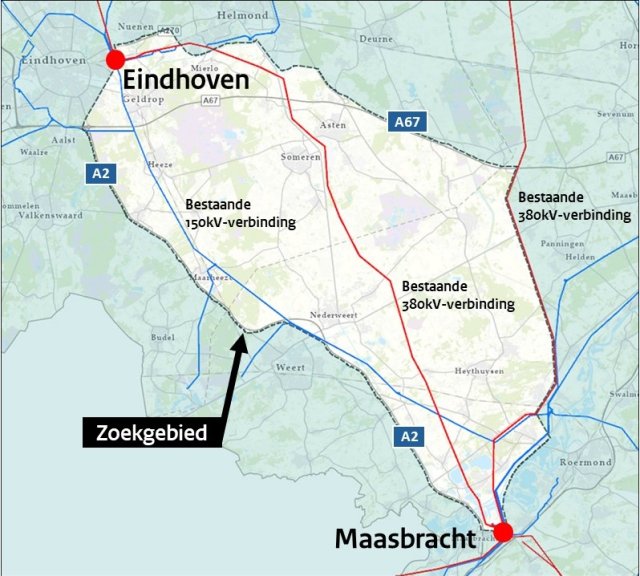An additional high-voltage line between Maasbracht and Eindhoven
There is a plan to build a new high-voltage line between Maasbracht and Eindhoven. This additional connection is needed because the existing high-voltage line between Maasbracht and Eindhoven, which is currently being upgraded, will not be able to carry enough power starting in 2030.
To determine exactly where the high-voltage line will be, a procedure is starting. This is necessary for the permits. You can respond to the plan now. Would you like to know more? Follow the webinar or come to a meeting.
Why this plan?
TenneT, the operator of the national high-voltage grid, has calculated that an additional high-voltage line will be needed here starting in 2030. Because the use of the national high-voltage grid is increasing. This is because of this:
- Demand and supply of electricity is increasing. This is due to population growth. And we are using more power with electric cars, homes and industry, for example.
- Much power will soon be generated by wind turbines at sea, rather than at a power plant on land. As a result, the power will have to travel a longer path to the user. This places greater demands on the high-voltage grid.
- Sun and wind sometimes give too much power and sometimes too little. When there is too much power, it is transported abroad. When there is a shortage, power is imported. That too requires more of the high-voltage grid.
Where will the additional high voltage line be located?
There is a large search area between the Maasbracht and Eindhoven high-voltage substations. This is where the high-voltage line is to be located. The new line should not be much longer than the existing one. Otherwise it won't work.

Within the search area, TenneT is looking at this:
- The connection will be above ground (except where there is really no other way)
- The connection will be as close as possible to sensitive buildings or town and village centers
- The connection will be as close as possible to protected natural areas
- The connection crosses as few other high-voltage lines as possible
- The joint will have as few bends or kinks as possible
- The connection preferably runs flush with existing infrastructure, such as a highway or other high-voltage line
What happens next?
A Proposal and Participation Plan is available for review. This is the first step in the procedure that ultimately ensures that all permits are in place for construction. In the Intention, TenneT describes the plans for the project. The Participation Plan describes how the surrounding area will be involved in the energy project. You can now share your suggestions, opportunities and concerns. These will be taken to the next step. Several more steps follow, in which the plan becomes more and more precise. This is how the Ministry of Climate and Green Growth and TenneT ensure that the high-voltage line is carefully fitted in. At the various steps, you will be given the opportunity to respond again and again.
Want to know more? Watch the webinar.
A webinar telling more about the project took place on Thursday, Oct. 17, at 7:30 pm. You can watch the webinar back.
Or come to a drop-in night!
There are also three walk-in evenings. You will then receive information at an information market where you can ask questions to employees of the Ministry of Climate and Green Growth and TenneT. You can also react to the proposal on the spot. You can walk in and out freely between 19:00 and 21:00. There is no general presentation. Registration in advance is not necessary.
The meetings are on:
- Monday, Oct. 28: Community tube d'n Binger in Meijel
- Wednesday, Oct. 30: The Baekerhoes in Brachterbeek
- Thursday, Oct. 31: Village Hall 't Perron in Heeze
These locations are distributed as best as possible throughout the search area. By the way, it does not automatically mean that the connection will pass by these 3 locations.
You can read more about the information meetings , the steps in the process and how to respond on the RVO website. More information about the project itself can be found on TenneT's website .